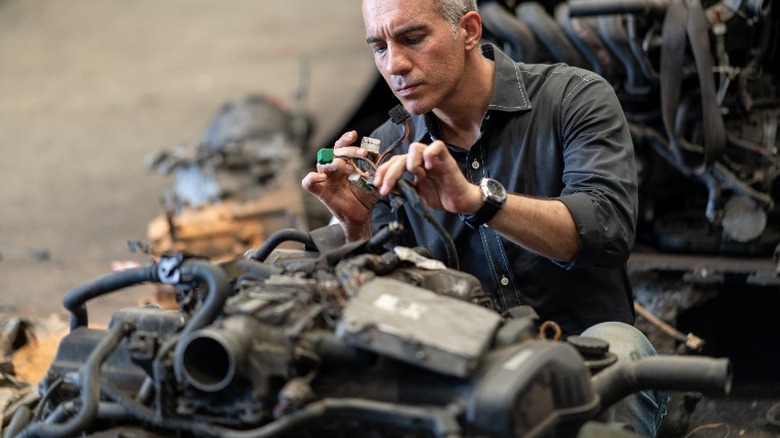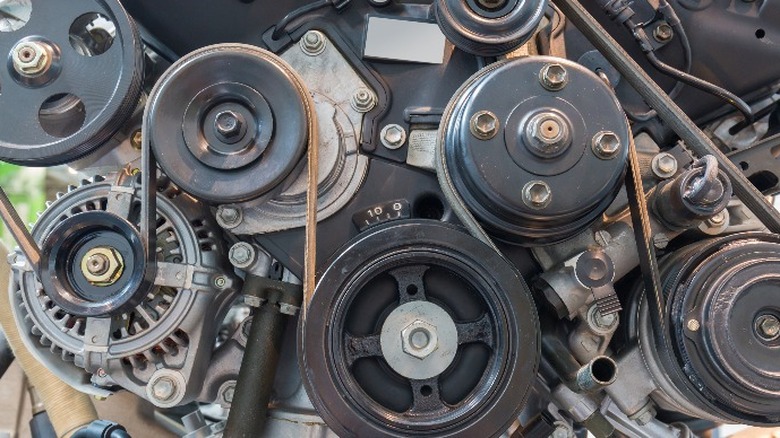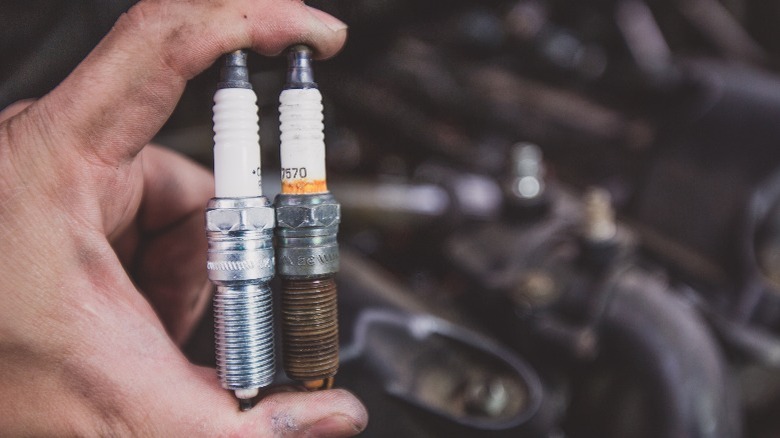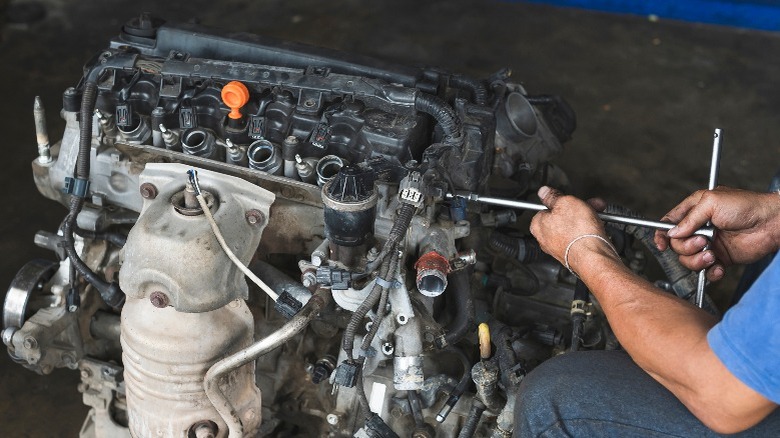6 Things To Look Out For If You're Buying A Junkyard Engine
So, you're buying a junkyard engine. Whether it's for a quick swap, a full-scale restoration, or a custom hot rod project, one thing is certain: buying a scrapyard engine is the start of an incredible adventure. Foraging in the wilds of your local junkyard, hunting for a diamond in the rough to match your needs, is an experience like no other. For puzzle-loving gearheads, buying a junkyard motor is like the ultimate scavenger hunt — with a fair helping of suspense and mystery.
That's right. Buying a junkyard engine comes with its share of mystery, which is sometimes responsible for turning those enjoyable experiences into full-blown nightmares. Unlike when shopping for a used or remanufactured engine online or with a dedicated engine seller, you don't usually get a lot of information about the parts at a scrapyard. A lot of things can go wrong when buying a motor of hazy origins. And the last thing you want is to drop several hundred bucks on an engine, lug it all the way home or to your shop, and then learn that it's a dud.
There are several general tips you should follow when buying a used engine. But buying a junkyard engine is a different beast, and there are many things you need to look out for when buying a scrapyard motor. From the donor car's origin and body condition to whether or not the crankshaft turns, here are six things to look for when buying a junkyard engine.
Donor vehicle origin and body condition
Vehicles arrive at the scrapyard for any number of reasons. Many of the cars you find in a junkyard are there because they were totaled in an accident. Others suffered mechanical failures or simply broke down with age. When buying an engine — or any other part — from a junkyard, it's important that you investigate the donor car's history whenever possible. Doing so can help you determine whether the engine is a solid investment or a money pit.
One of the most important things you should check out includes the donor vehicle's body and history. If the engine is still in the car, perform a quick inspection. Look for damage that could tell you why the car was scrapped. For example, if the car was totaled in a rear-end collision, it's generally safe to assume that the engine was not damaged. However, if the car's body is in pristine condition, it may be an indication of a mechanical problem, like a faulty engine. Furthermore, if the vehicle was involved in a front-end collision or a rollover, the engine may be compromised at best or completely destroyed at worst.
If possible, you should also check the car's odometer to determine roughly how many miles are on the engine. If the motor is still bolted into the vehicle, try to start it up and see how it runs. If the engine is out of the car, ask an employee if they have any records for the donor vehicle and why it was brought to the scrapyard.
Check your junkyard engine's exterior condition
Once you've identified a viable donor car for your junkyard engine, it's time to move on to the real inspection process. This is when you'll need to bust out your magnifying glass and go over the motor with a fine-tooth comb, looking for any defects or damage that could affect its performance and reliability.
Whether or not the engine is still in the donor car, there are a few external parts you need to inspect. First, look over the motor's exterior. Check the block to make sure it's not cracked or damaged. Inspect all of the accessory parts, including pulleys, tensioners, brackets, electrical connections, hoses, and more. If any parts are missing or broken, move on to the next prospective engine. Be sure to check the motor mounts and the flywheel where the engine connects to the transmission. Bring a flashlight with you, and check out the holes for things like the exhaust manifold and engine mounts — if the threads are stripped or warped, it could be a sign of greater damage. Inspect the oil pan for dents, holes, or cracks and the valve cover for signs of leaks and general damage.
Next, look for specific types of damage. Make sure the engine doesn't appear to have been sitting out in the rain or exposed to the elements. Check for signs of excessive oil leaks, like grime buildup and dark spots, and signs of coolant leaks, like crusty build up around hoses and cooling system components.
Can you turn the crankshaft?
After you've given your junkyard engine's exterior a solid inspection, it's time to check out some interior components. While it's not usually possible to tear down a scrapyard engine to analyze every internal part before you buy it, you can perform a basic and thorough inspection in the yard to help avoid some of the most commonly used engine problems. One of the most important things to check when purchasing a junkyard engine is whether you can spin the crankshaft.
The crankshaft is a vital internal engine component. As small explosions propel the motor's pistons up and down, the pistons transfer that energy to the crankshaft. As a result, the crankshaft spins extremely fast, sending power to various other parts of the drivetrain, including other engine parts, like the timing chain, camshaft(s), and belt pulleys, as well as the transmission.
You can spin the crankshaft manually using a ratchet and socket on the large nut on the crankshaft pulley, which is usually the largest pulley on the engine and located toward the bottom of the block. You should try to turn the crank two times: once with the spark plugs installed and once without them. When the spark plugs are installed, there should be some resistance when turning the crank. If the crankshaft spins freely with the spark plugs installed, that means there's a compression problem, and you may want to consider another motor. Without the spark plugs, the crank should spin relatively easily. If you can't turn the crankshaft at all, it could mean that the engine is seized, and you'll need to hunt for another motor.
Check the spark plugs
Spark plugs are critical components for gas-powered internal combustion engines. They're responsible for creating the spark that ignites a fuel/oxygen mixture inside the engine, and inspecting the spark plugs can tell you a lot about the motor's condition.
We already mentioned that you should pull the spark plugs while checking to see if the crankshaft spins. It's a great idea to inspect the plugs and their tubes while you're doing this. When you pull the spark plugs, you should focus primarily on the electrode side (i.e., the part that screws into the cylinder head). Normal spark plugs are grayish-brown or tan. They should look used and discolored, but free of excessive buildup or burn marks. Unhealthy spark plugs can have various appearances. Black or sooty looking electrode tips may be indicative of carbon fouling, while oily or grimy looking plugs could mean that oil is leaking into the cylinders.
Various other discolorations and types of damage can indicate other engine problems. While some of these issues may be relatively minor or the result of incorrectly installed plugs, they should always be interpreted as red flags when buying a used or junkyard engine. You can take the risk if you want, but if the spark plugs are in poor condition, you're probably better off hunting for a different motor.
Inspect the oil cap and dipstick
Most people are aware of how critical oil is for a car's engine. It not only helps lubricate the motor's internal parts, but it also helps prevent extreme temperatures by functioning as a heat sink. However, many people may not know that motor oil can also help us diagnose engine damage, and it's especially important to check the oil when purchasing a used car or a junkyard motor.
Even if the junkyard engine has no oil in it, you should pull the dipstick and the oil fill cap to inspect them. Look for signs of internal damage, like metal shavings or chunks of grime and sludge, and signs of contamination, like milky or watery residue. If the engine is still full of oil, check its condition. You'll want to look for the same signs, but in the oil itself. Milky or frothy oil is usually a sign that coolant or water has entered the system, which, in most cases, means head gasket damage. Metal shavings or heavily contaminated oil can indicate broken parts and deep engine damage.
All of those are red flags in a junkyard engine. The motor oil can be dirty. But if it looks extremely discolored or full of contaminants, you'll probably want to pass on that engine and find one in better condition.
Pull the valve cover and oil pan
Even if you can't completely disassemble a junkyard engine before buying it, you can remove a few easily accessible parts to get a glimpse into the motor's internals. The valve cover and oil pan are both easy to remove and can provide valuable insights into the engine's overall condition.
The valve cover or cylinder head cover is located on top of your engine. V-style engines will have two valve covers, while inline motors have one. You may need to remove a plastic engine cover to access the valve cover, but other than that, it's very easy to remove. When you pull the cover, the engine's valve train and spark plug tubes will be exposed. You should look for signs of damage, like grime buildup, scorch marks, and metal shavings.
The oil pan is equally easy to access and remove. It's located on the bottom of the engine and functions as a reservoir for motor oil. Removing it is simple and involves disconnecting a series of bolts. When you remove the pan, look for signs of overheating, like black marks or scorched areas, and any other signs of damage, including metal shavings, broken parts, or grime buildup.
If you notice anything out of the ordinary when inspecting these areas, you should reconsider the engine. Internal damage is no joke, and even if it appears minor, it could be a sign of far deeper and more severe problems or the beginning of a long and expensive repair process.






